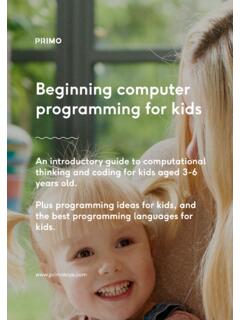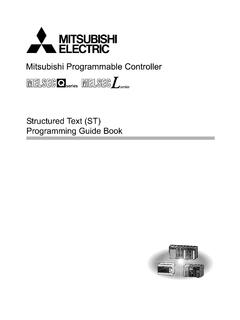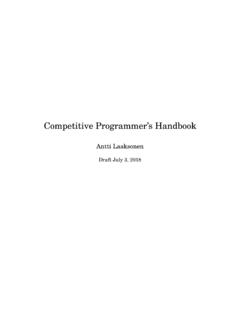Transcription of Beginning computer programming Beginning computer ...
1 Primo Toys Beginning computer programming Beginning computer for kids: programming An introductory guide to for kids computational thinking and coding for kids aged 3-6 years old. An Plusintroductory programming guide to for ideas computational thinking kids, andand the coding for kids aged 3-6. best programming years old. for kids. languages Plus programming ideas for kids, and the best programming languages for kids. Table of Contents Hello 3. Why a book and why now? 5. Who is this book for? 6. How does this book work?
2 7. Who will find each secion most useful? 8. Part One 9. What do we mean by introducing computer programming for kids? 10. Why should kids learn coding and computational thinking at all? 13. A brief history of coding education for kids 19. Part Two 23. The use of age groups in the eBook 24. Section i) Three to Four Years Old 25. Section ii) Five to Six Years Old 57. Part Three 73. What Next? 74. Glossary 80. Bibligraphy 83. Hello Hello, we are Primo Toys. We're a team of technologists, designers and educators who make toys that help children learn with technology.
3 You may already know our first toy, Cubetto a playful wooden robot that helps young children aged 3+ learn the basics of computer programming through hands-on play, without a screen. We started building it back in 2013, and we made a bit of a splash last year when we launched Cubetto on the crowdfunding platform Kickstarter. We raised $ , becoming Kickstarter's most-funded educational technology project ever. At the time there were just five of us in the team. Now we are 17 and, after another Kickstarter campaign we look like this: 3.
4 We created Cubetto because, like an increasing number of academics and experts, we believe that coding for kids is a new kind of literacy for the 21st century.. We think that for girls and boys, all over the world, learning to program will be as important as their ABCs and 123sw in helping them understand the world around them. We believe that introducing children to a world of algorithms, bugs and queues also develops their problem-solving skills, encourages collaboration and nurtures children's creativity.
5 Like Maria Montessori, the Italian educationalist acclaimed for her method that builds on the way children naturally learn, we think that children learn best through play. We also know that they're motivated by challenges; and that at very young ages, abstraction (the ability to think about a solution to a problem without trying it out first), is difficult. Coding is a new kind of literacy for the 21st century. 4. 4. Our aim is to help create a new global standard for coding education that incorporates this and other approaches to the way children learn best, both at home and in the classroom.
6 We want to help a new generation to realise their full creative potential in a world of rapidly increasing technological progress. This ebook is part of that mission. Why a book and why now? In the four years since we started, learning software programming for kids once a niche and nerdy enterprise has elbowed its way politely into the mainstream. Well-publicised and well-funded private and public campaigns (often helped along by very well- known entrepreneurs and stars Mark Zuckerberg, Bill Gates, ) have helped make this possible.
7 A growing number of innovative designers, researchers, and of course crowdfunding platforms, have also helped propel coding toys and programming games to new heights. Children as young as three or four can now use block-based, tangible coding languages like our own or Kibo or Google's Project Bloks; while older children can build and program their own robot kits including Lego Mindstorms and LittleBits. And then there's a growing number of programming languages for kids, like MIT's ScratchJr designed for five to seven-year-olds.
8 Meanwhile, in some countries including the UK, programming is already part of the curriculum, and there are a huge number of schools that teach coding around the world. So there's never been more information for parents and teachers dedicated to helping to get kids coding. If you Google kids' coding ebook' you'll find plenty of engaging publications that offer a step-by-step initiation to a variety of coding languages, all aimed at Beginning computer programming for kids. 5. The problem is that many of these have been written to complement formal schooling, which typically starts in most countries around ages five or six, and have been written for teachers rather than parents.
9 So we decided to produce something that could also help children aged three to six. An introductory guide that brings together all those vital hands-on learning techniques and imaginative tips and tricks we've learned and developed over the years. Who is this book for? This book is primarily for parents who are keen to find out more about what computer programming is, and how they can introduce easy programming for kids in a fun and engaging way. We also hope that teachers, particularly those less familiar with coding and its key concepts,will find it useful both as an introduction and a tool for their lessons.
10 6. How does this book work? In Part One: Introducing coding for kids', we dip into some of the key terminology that we'll use throughout the book that typically causes confusion. We'll also ask: Why learn to code in the first place?'. In addition, there's a brief but important history of educational coding, which introduces some of the bright minds and stunning innovations that got us to where we are today it sets the scene for the rest of the book, so please don't skip it! In Part Two: We look at two different age groups: Section i.








